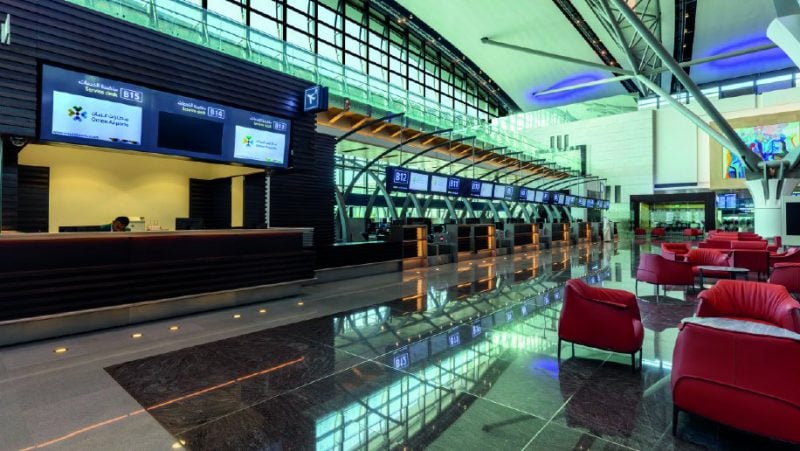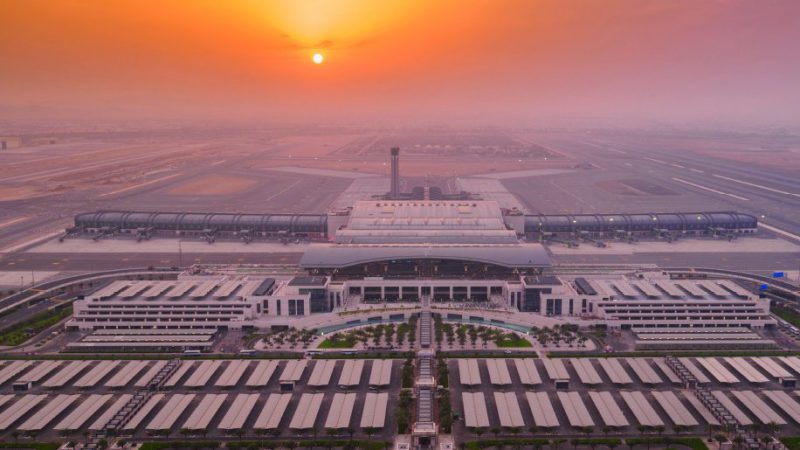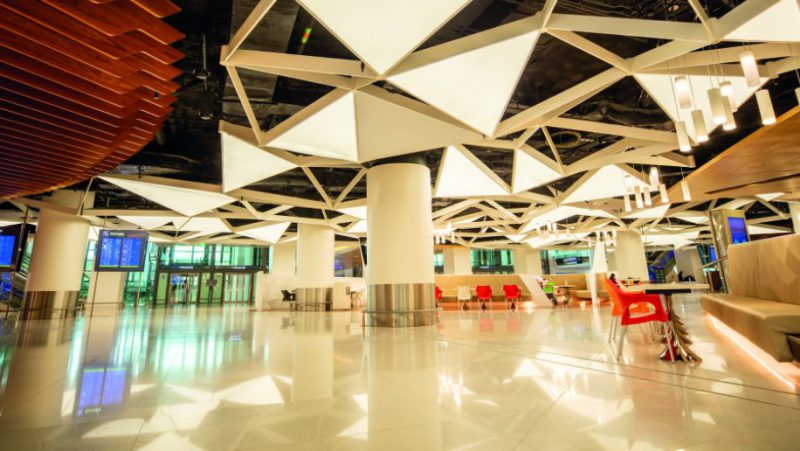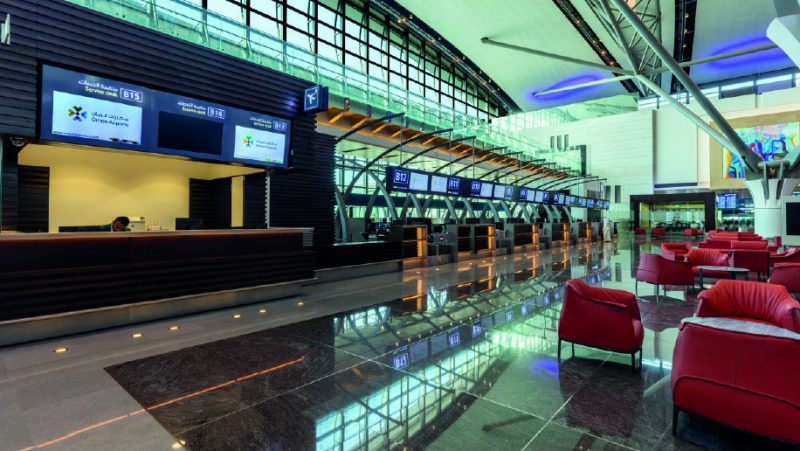Expanded Horizons
The improved Muscat International airport has ushered in a new era of aviation for Oman
November 30, 2019


A hairdryer-like wind blows fiercely near the top of the 318-foot-tall air traffic control tower at Muscat International airport. The narrow terrace has a see-through design that sparks some mild acrophobia. From here you can see the decommissioned airport on the other side of the old runway and, directly beneath, the three-pier new terminal, which opened in March last year. Even at the height of a humid summer’s day, it is a striking view and all the more powerful for its symbolism – uniting Oman aviation’s past, present and future.
Seasoned business travelers will have fond memories of the old airport, as chauffeur transfers took you directly from plane to immigration, and you could be out in a taxi in minutes – although economy passengers won’t miss the bus transfers. Only a fraction of flights now require remote transfers and most passengers arrive and leave swiftly via 40 jetways. As for car transfers, that’s now strictly for VIPs.
The former airport, which opened in 1973, became inadequate as Oman’s economy grew and more leisure travelers flocked to the Sultanate’s abundant natural wonders. Still, the construction journey at the new one wasn’t without its challenges, which led to delays.
 A year and a half on, memories are fading. Terminal duty manager Ashraf Amir Ali Al Hinai shows me around the 3.7 million-square-foot facility, which is about seven times the size of the former Seeb International airport. My favorite then-and-now is the elevators – three then compared with 118 now.
A year and a half on, memories are fading. Terminal duty manager Ashraf Amir Ali Al Hinai shows me around the 3.7 million-square-foot facility, which is about seven times the size of the former Seeb International airport. My favorite then-and-now is the elevators – three then compared with 118 now.
It has been well received, jumping from 75th spot in Airports Council International’s Airport Service Quality rankings in the last quarter of 2017 to 14th a year later (among airports with 15-25 million passengers). The goal is to climb into the top ten. Last year it handled 15.3 million passengers and this year it is forecasting 16.3 million. Oman Air handles 60 percent of all flights here with services throughout the region and as far afield as London Heathrow, Mumbai, Guangzhou and Kuala Lumpur.
Growing Ambitions
Historically, such ambition would sit uneasily with conservative Omanis. There is still a will to develop gradually and they forever reject comparisons with Dubai, an hour’s flight, and an aviation world away, to the northwest.
Nearby corporate magnet, the Oman Convention and Exhibition Centre, has seen further developments, with Crowne Plaza opened and JW Marriott coming soon. Amid uncertain oil markets, MICE and tourism is becoming critical to Oman’s growth.
While the goal is to increase point-to-point travel, about 58 percent of the airport’s traffic is transfer, predominantly between Europe and the Indian subcontinent, so it means there aren’t departures and arrivals pressure points even though numbers are growing.
Beside the tower terrace is the stretch that will serve as the phase-two extension; this will increase capacity to 24 million and a fourth phase will ultimately have space for up to 48 million passengers. Still, David Wilson, chief operations officer for Oman Airports, says that while passenger numbers are growing, it is “some way off” reaching the first-phase capacity of 20 million passengers. “Rather than initiating a large spend for phase two, we shall be introducing new technologies such as self-service check-in and bag drop, thereby maximizing available space,” he says.
 Smooth Flow
Smooth Flow
Oman Air’s first and business class check-in area is located in Zone A. Alongside a series of seating areas are 12 check-in desks with opulent finishes. Premium travelers walk through a short corridor to four immigration counters and dedicated security screening. Altogether, there are 120 check-in counters, with Zone B reserved for international airlines and C and D for Oman Air economy.
For all the capacity jump, the terminal could still be described as “Gulf airport in miniature” compared with its rival hubs in the region. All the same, the generous use of dark sheesham wood, white marble and elaborate three-shelf exterior mashrabiya designs indicate a huge capital investment. One standout feature is a silver shimmering sculpture that evokes Oman’s nearly 2,000 miles of coastline.
Arrivals has interlinked escalators to Departures and a mezzanine level, which has a smattering of food and beverage outlets and will be further developed. There are ten enclosed public lounges, some of which are converted to prayer rooms during Hajj.
From Departures on level four, premium passengers take the elevator up a floor to the expansive Primeclass (international common-user) lounge, the gold and white Oman Air first and business class lounge (first class is in a separate area behind silver doors) and a 90-room Aerotel transit hotel.
A new Majan lounge is coming on level seven, which will give international airlines and their passengers more choice.
The duty-free below is a little cramped and not easy to navigate for first-timers but passengers will find accessible brands at the center and more high-end names, such as Montblanc, at the North pier. Home-grown brands include Amouage, which enjoys a prime spot, and Kahwaji cafe.
Regional Forces
Oman’s political neutrality is being tested with the ongoing UAE and Saudi blockade of Qatar, and war in neighboring Yemen, but the surge in direct and transit business from Qatar Airways has brought benefits.
Emirates introduced two daily A380s in July – breaking its own record for the world’s shortest superjumbo flight – while retaining one 777 service. An Emirates spokesperson said it had “nothing to do with the political issues” and was in response to Oman/UAE demand. Other reports have claimed the move was motivated by the grounding of codeshare partner Flydubai’s 737 Max aircraft.
In any event, the superjumbo’s arrival, together with the new terminal, has heralded a new aviation era in Oman. “The opening of the new terminal will support Oman Air’s fleet and network expansion program, and allows us to offer a thoroughly enhanced service,” an airline spokesperson says. “Such expansion means we will be able to operate more international and domestic flights out of Muscat.”




